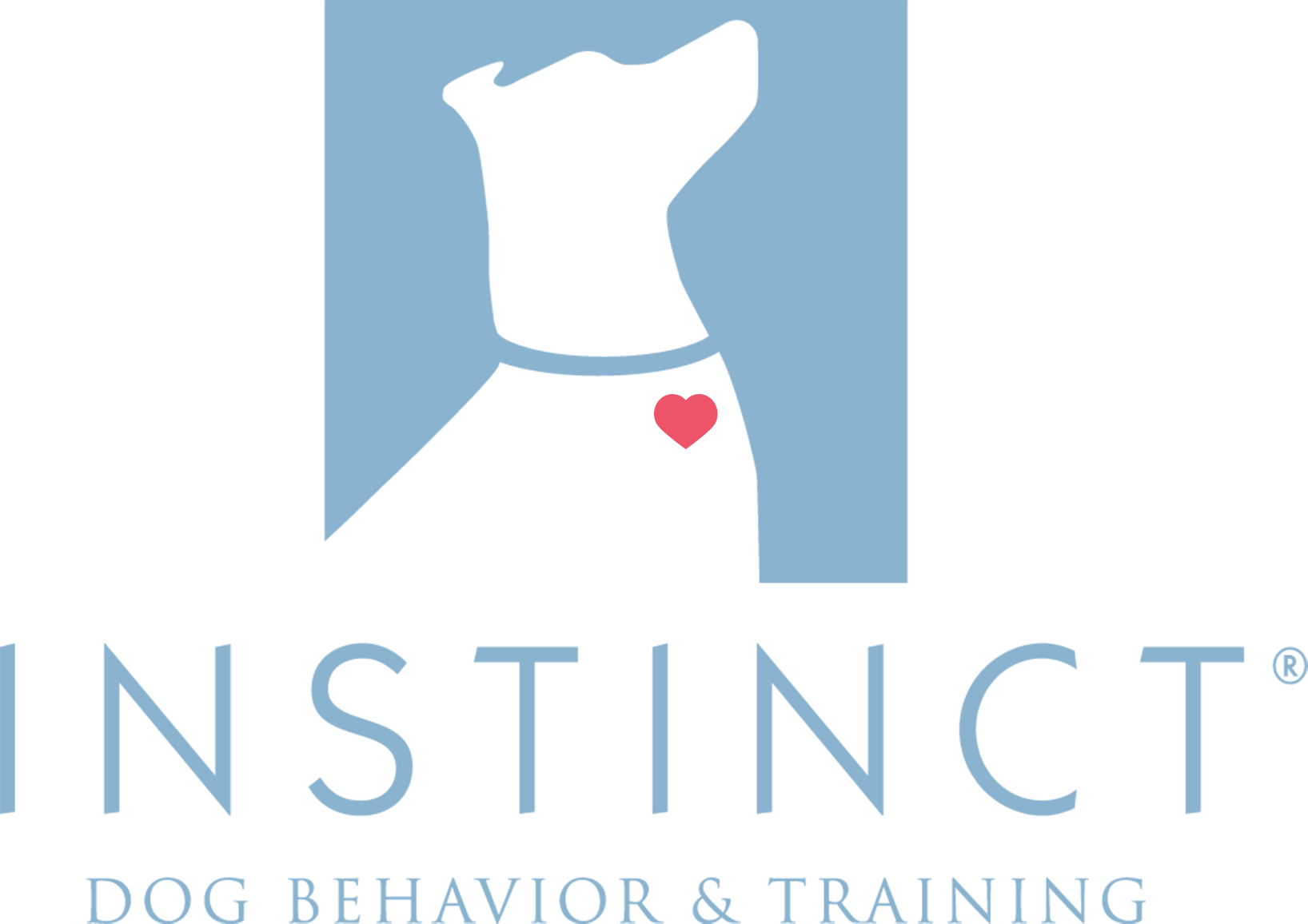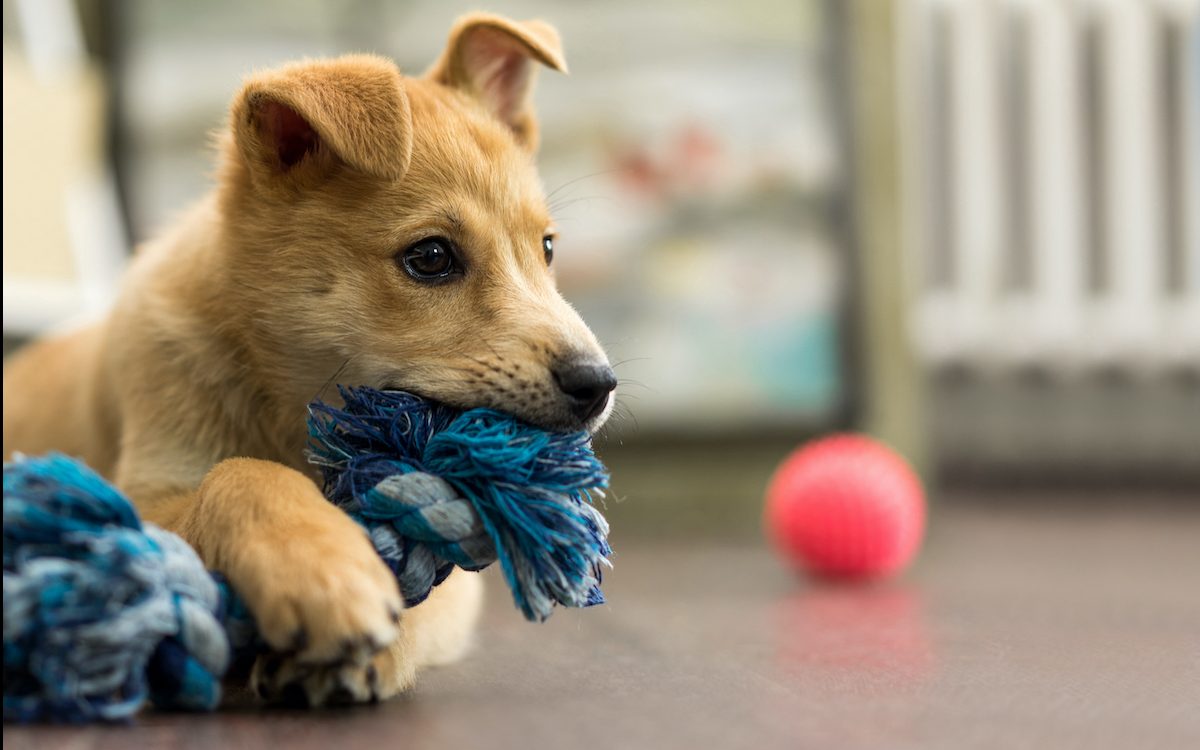A Behavioral Guide for Owners of Dogs Ages 6- to 12-Months
Your puppy is growing up! As puppies enter early adolescence, it is important to understand that – just like human teenagers – their behavior will naturally change and develop, particularly when it comes to play with other dogs; listening skills & manners; and conflict resolution strategies.

Let’s take a closer look at how our pups’ needs change in each of these important areas.
I. PLAY WITH OTHER DOGS
 Playtime with other dogs can be an important social activity for dogs at every stage of their life. However, our dogs’ socialization needs change over time, and adolescence is no exception! The socialization experiences our dogs have during adolescence can have a lasting impact on their long-term outlook on dog-dog play.
Playtime with other dogs can be an important social activity for dogs at every stage of their life. However, our dogs’ socialization needs change over time, and adolescence is no exception! The socialization experiences our dogs have during adolescence can have a lasting impact on their long-term outlook on dog-dog play.
Here’s what you should know about dog-dog play during early adolescence:
1. Other Dogs May Start to Treat Your Pup Differently
Between 5-6 months, your pup’s “Puppy Pass” expires. Dogs will begin to hold your puppy to a more adult standard of appropriateness when it comes to dog-dog interactions.
What does this mean?
- Typical puppy behaviors – biting at tails, ears and cheeks; placing paws up on other dogs’ shoulders; recklessly running into others; lots of muzzle licking, etc. – that were previously tolerated by adult dogs may now elicit a mild or moderate correction instead.
- These corrections can be scary to still-young pups who are left wondering why other dogs are suddenly taking offense to their super-cool puppy play moves.
2. Your Puppy May Start to Engage with Other Dogs Differently
Young adolescents may start to test the boundaries of appropriateness when interacting with other dogs. They can experiment with rude and impolite behaviors, and they often miss or ignore more subtle communication signals from other dogs asking them to tone it down.
What does this mean?
- It is important to choose play partners carefully during adolescence. Pups need to learn boundaries for polite play to avoid developing bullying tendencies, but they are also still young, sensitive, and highly impressionable.
Tips for Navigating Dog-Dog Play Sessions During Early Adolescence
There are some simple guidelines you can follow to set your young adolescent dog up for success during dog-dog play:
- Learn to read dog body language during play, so you can identify when your dog (or their playmate) needs a break, when things are getting out of hand, and when everyone is having a good time.
- Teach your dog a solid recall cue so you can call them out of dicey situations.
- Choose the right playmates:
- Other adolescent pups of similar size and play style
- Patient, socially savvy adult dogs who enjoy play and set clear boundaries through fair, appropriate feedback
- Avoid the wrong playmates:
- Baby puppies aged 8-16 weeks are generally not well-suited to play with young adolescent dogs, as the “teenagers” can slip into bullying behaviors and overwhelm young pups. Exceptions include shy and very mild mild-mannered adolescents.
- Stay away from adult dogs who are quick to give overly harsh corrections, especially if they are larger than your adolescent pup. Remember, your puppy is still young and impressionable; regular exposure to adult dogs who respond to careless play with inappropriate levels of aggression can leave your pup with lasting feelings of insecurity and uncertainty about interacting with other dogs.
- Opt for 1-on-1 play sessions, or a small, well-matched group.
- Start with a calm, low-arousal activity like a parallel walk or some training practice, before starting playtime. High arousal levels equal a higher likelihood of poor decisions and altercations.
- Keep play sessions relatively short, about 25-45 minutes. Any longer than that, and dogs typically start to run low on self-control, making them more likely to make poor decisions.
II. LISTENING SKILLS & MANNERS

As pups enter adolescence, they can become less responsive to known obedience cues and seem to suddenly forget their manners (sound familiar, parents of human tweens and teens?!). It is important to remember that your dog isn’t purposefully trying to be bad or to aggravate you. They are going through a totally normal – if sometimes frustrating – phase of their development.
What does this mean?
1. It’s Time to Train!
Now is the time to double-down on daily positive reinforcement-based training that focuses on fun, engagement, cooperation, and trust.
- Your puppy is growing up! It is natural that they want to broaden their horizons, exercise their independence, and experiment with new behaviors.
- Choose playful, positive reinforcement-based training that fosters a dynamic in which your growing pup genuinely enjoys listening to and engaging with you, and trusts that you are ALWAYS a safe place to turn as they explore their independence.
- KEEP IT POSITIVE! Resist the urge to turn to harsher, more aversive training techniques in an attempt to shut down these sometimes -obnoxious teenage behaviors. You’ll run the risk of destroying your pup’s trust in you as a safe place to turn while they figure out the world around them, and you can inadvertently create more serious, long-lasting behavior issues in the process.
2. It’s Time to Manage the Situation!
It is normal to need to make some temporary adjustments to your environment and routine, to temporarily scale back on certain freedoms and add in safety & management measures, in order to set your pup up for success during early adolescence. Here are some common examples:
- Owners often need to utilize a long line during off-leash time for a little while, to ensure their pup’s recall stays reliable during adolescence.
- Adolescent dogs are LARGER than puppies, and their cognitive abilities are increasing, too. It is common to use a gate to keep your adolescent pup out of the kitchen to prevent them from discovering the joys of counter-surfing and trashcan-raiding.
III. CONFLICT RESOLUTION STRATEGIES
 As our puppies transition into adolescence, they may begin to experiment with solving problems in a more adult manner. Sometimes, these new behaviors are just temporary blips that are a normal part of development, and are nothing to be concerned about. Other times, they are an important signal that our pups need help with confidence building and coping skills to ensure these new behaviors don’t turn into longer term behavior issues.
As our puppies transition into adolescence, they may begin to experiment with solving problems in a more adult manner. Sometimes, these new behaviors are just temporary blips that are a normal part of development, and are nothing to be concerned about. Other times, they are an important signal that our pups need help with confidence building and coping skills to ensure these new behaviors don’t turn into longer term behavior issues.
What to Watch for:
- Puppies who displayed fearful or cautious behavior around certain people, dogs or objects may now begin to display more proactive distance-increasing behaviors – lunging, snapping, barking – toward those concerning triggers.
- Puppies who displayed overly submissive body language or appeasement behavior when meeting other dogs (e.g., immediately rolling over and exposing their belly/groin, excessively licking other dogs’ muzzles, etc.) may experiment with more forward communication signals that indicate their discomfort and desire for space. Growling, raising a lip, snapping, and lunging are all new tactics that may be utilized to ask the other dog to move away.
It is a great idea to work with a skilled trainer or behavior consultant during this important phase of your pup’s life, so you can identify which behavior changes are a normal part of development, and which should be addressed with specific behavior modification efforts.
RECAP: UNDERSTANDING CHANGING BEHAVIOR NEEDS DURING EARLY ADOLESCENCE
Remember, changes in behavior are NORMAL as your dog progresses through different stages of development. Here are three common changes that may occur during early adolescence:
- Your dog’s behavior around other dogs may change during adolescence. Providing opportunities for safe, healthy play with appropriate play partners is important.
- Your dog’s responsiveness to obedience skills may change, and you may see a regression in manners. Don’t panic! Implement daily positive reinforcement-based training that focuses on fun and engagement.
- Your dog’s conflict resolution strategies may change, and they may experiment with more proactive behaviors to create space for themselves. Work with a trainer to determine whether these changes are a normal part of development, or something that should be addressed via behavior modification.
Learn More about Canine Adolescence
Check out Canine “Teenagers”, a seriously awesome episode of our podcast, DogLab, featuring Dr. Naomi Harvey of Dogs Trust. Dr. Harvey discusses her recent (fascinating) research on canine adolescence and provides a ton of helpful info and advice on helping owners navigate through this phase of development in a positive manner.
Feeling Overwhelmed?
Adolescence is different for every dog, with some presenting more challenging issues and behaviors than others. Hang in there! There is help available. Reach out to us at Instinct, or find a certified dog behavior consultant near you via www.iaabc.org.



